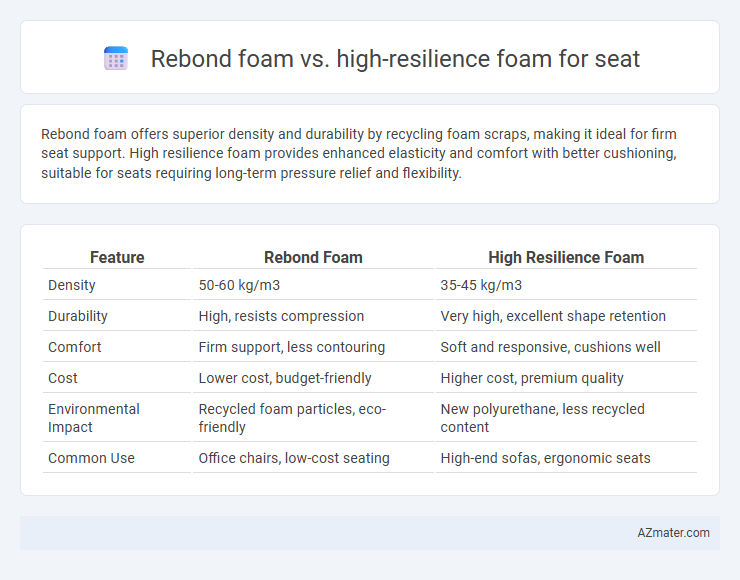Rebond foam offers superior density and durability by recycling foam scraps, making it ideal for firm seat support. High resilience foam provides enhanced elasticity and comfort with better cushioning, suitable for seats requiring long-term pressure relief and flexibility.
Table of Comparison
| Feature | Rebond Foam | High Resilience Foam |
|---|---|---|
| Density | 50-60 kg/m3 | 35-45 kg/m3 |
| Durability | High, resists compression | Very high, excellent shape retention |
| Comfort | Firm support, less contouring | Soft and responsive, cushions well |
| Cost | Lower cost, budget-friendly | Higher cost, premium quality |
| Environmental Impact | Recycled foam particles, eco-friendly | New polyurethane, less recycled content |
| Common Use | Office chairs, low-cost seating | High-end sofas, ergonomic seats |
Overview of Rebond Foam and High Resilience Foam
Rebond foam is manufactured by bonding shredded foam scraps together, resulting in a dense and firm material ideal for high-impact seating applications requiring durability and support. High resilience foam features an open-cell structure with superior elasticity and bounce, offering enhanced comfort and long-term shape retention in seats. Both foams serve different purposes: rebond foam excels in heavy-duty furniture due to its toughness, while high resilience foam is preferred for cushioning that demands softness and resilience.
Key Differences Between Rebond and High Resilience Foam
Rebond foam is created by shredding and bonding scrap foam pieces, resulting in a dense and firm material ideal for heavy-duty seat support and durability, whereas high resilience foam is a flexible, molded polyurethane foam known for its superior elasticity, responsiveness, and comfort in seating applications. Rebond foam typically offers higher density and less bounce-back compared to high resilience foam, which excels in providing pressure relief and prolonged cushioning without losing shape. The key difference lies in rebond foam's emphasis on structural support and cost-effectiveness versus high resilience foam's balance of comfort and dynamic support.
Composition and Manufacturing Process
Rebond foam is made by shredding and bonding scrap polyurethane foam pieces using adhesives, resulting in a dense, durable material ideal for heavy-duty seating applications. High resilience foam is produced through a specialized chemical process that creates a highly flexible and elastic polyurethane foam with open-cell structure, offering superior support and comfort. The manufacturing of rebond foam emphasizes recycling and compression, while high resilience foam focuses on controlled polymerization to enhance load-bearing capacity and longevity.
Durability and Longevity Comparison
Rebond foam, made from recycled foam scraps bonded together with adhesive, offers moderate durability but tends to compress faster over time compared to high resilience (HR) foam. HR foam, characterized by its open-cell structure and higher density (typically 1.8 to 2.8 lb/ft3), delivers superior longevity with better shape retention and resistance to sagging in seats. Choosing HR foam ensures longer-lasting comfort and durability in seating applications due to its enhanced elasticity and resilience properties.
Comfort and Support Levels
Rebond foam offers firm support and durability by combining scrap foam pieces into a dense, resilient material ideal for high-traffic seating areas. High resilience (HR) foam provides superior comfort with its open-cell structure, promoting excellent cushioning and pressure distribution for prolonged seating comfort. The choice depends on prioritizing either robust support from rebond foam or enhanced comfort and flexibility from HR foam in seat applications.
Applications in Seat Cushioning
Rebond foam offers enhanced durability and firm support, making it ideal for high-traffic seat cushioning such as office chairs and public seating where long-lasting performance is critical. High resilience foam provides superior elasticity and comfort, responding quickly to pressure, which suits premium automotive and luxury furniture seats requiring prolonged comfort and ergonomic support. Both foams balance resilience and density, but rebond foam excels in structural integrity while high resilience foam prioritizes comfort and responsiveness in seat applications.
Cost Analysis: Rebond vs HR Foam
Rebond foam typically costs 30-40% less than high resilience (HR) foam, making it a budget-friendly option for seat cushioning in commercial and residential furniture. While rebond foam offers adequate durability and stiffness by compressing shredded foam scraps, HR foam provides superior elasticity and longer lifespan due to its open-cell structure. When balancing initial investment against longevity and comfort, rebond foam suits short-term or cost-sensitive projects, whereas HR foam delivers better value for high-use seating requiring enhanced support and durability.
Environmental Impact and Sustainability
Rebond foam, made from recycled foam scraps bonded together, significantly reduces landfill waste and lowers environmental impact compared to high resilience foam, which is typically derived from petrochemical sources and involves higher energy consumption during production. High resilience foam offers durability and comfort but contributes more to carbon emissions and non-biodegradable waste over its lifecycle. Choosing rebond foam supports circular economy principles by repurposing materials and minimizing ecological footprints in seating applications.
User Experiences and Reviews
Rebond foam provides excellent durability and firm support, making it ideal for heavy-use seats, as users report reduced sagging even after prolonged use. High resilience foam is praised for its superior comfort and elasticity, offering a more responsive seating experience that quickly adapts to body contours. Reviews highlight that while rebond foam excels in longevity and cost-effectiveness, high resilience foam outperforms in comfort and breathability, appealing to users prioritizing cushioning and pressure relief.
Choosing the Right Foam for Your Seats
Rebond foam offers exceptional density and durability, making it ideal for heavy-use seats requiring long-lasting support and firmness. High resilience (HR) foam provides superior elasticity and comfort, quickly regaining its shape for enhanced cushioning and breathability in seating applications. Selecting the right foam depends on balancing durability with comfort needs, where rebond foam suits sturdy, budget-friendly options and HR foam fits ergonomic, premium seating solutions.

Infographic: Rebond foam vs High resilience foam for Seat
 azmater.com
azmater.com